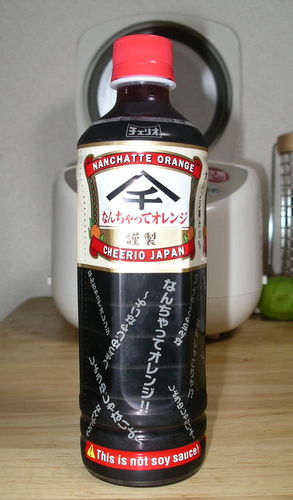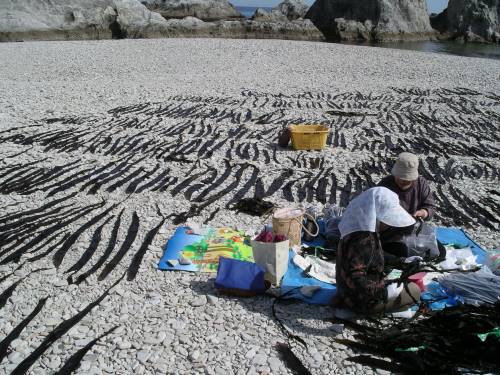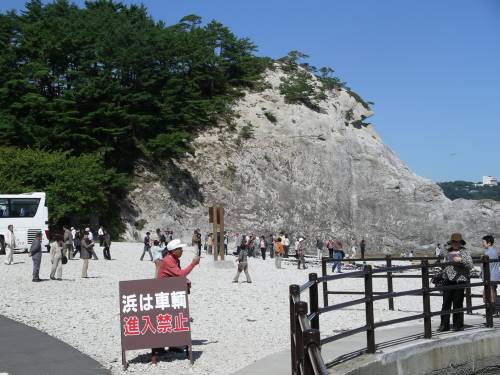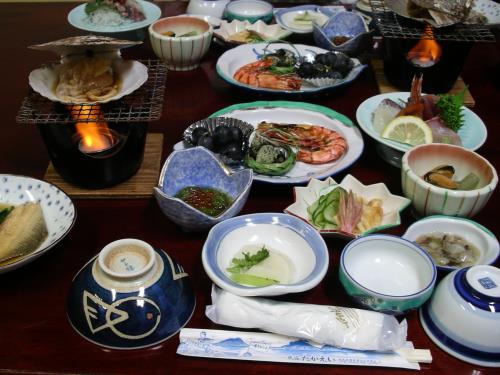If you ever need to buy soy sauce at the conbini, be sure to read the label first:

I love how emphatic the beverage is about not being soy sauce.
I love how emphatic the beverage is about not being soy sauce.
|
If you ever need to buy soy sauce at the conbini, be sure to read the label first:
I love how emphatic the beverage is about not being soy sauce. Winter has already arrived in Kitakami, which means it's time to start making nabe. Nabe is the Japanese word for cooking pot; the term is also applied to various one-pot dishes like soups, stews, or sukiyaki. One of our favorite nabe comes from Akita Prefecture: kiritanpo nabe.
Kiritanpo is made by mashing cooked rice into a paste, then shaping the paste around a stick and grilling it. Because they get soft rather quickly, they're added to the nabe toward the end of cooking. Chicken thigh, shirataki (noodles made of devil's tongue jelly), maitake mushrooms, carrots, and seri (Japanese parsley) rounded out the nabe. It was the perfect dish for a frigid, rainy night. When you get damaged or misdirected mail in America, it usually arrives with some sort of brief explanation. Often, the explanation is an impersonal form with one of multiple preprinted reasons checked off (or the ever-popular "Other," with a terse, often illegible explanation). It might also say "We apologize for any inconvenience," or something like that. It's all very cold and official.
Not so in Japan: This came on a piece of mail we'd been expecting to arrive from America last month. It says, essentially: "This mail was sent from America to Jamaica, then arrived in Japan on November 13. The honorable customer's important mail was delivered late, and for that, we offer our deepest apologies." Interestingly, it seems that mail from America bound for Japan gets sent to Jamaica often enough to warrant preprinted labels with spaces to write in the date. Unlike last year, I haven't been getting sick on a monthly basis. Unfortunately, I have gotten sick enough to require my first visit to a doctor in Japan. As one does, I went to the doctor that came recommended by a student. This doctor had the added benefit of having the most entertaining office sign in Kitakami:
Unless you're presenting with a dire emergency, the medical intake process in Japan is very DIY. The nurse handed me a digital thermometer along with the patient information sheet so that I could take and record my temperature. Once that was done, she pointed me to the self-service automatic blood pressure cuff. Much like the photo booth at the drivers' license center, the machine exhorted me to relax before pressing the button to activate it. Communicating with the doctor was not as hard as I feared it would be, save for a misunderstanding about why needles were going to be involved. After doing a blood test and determining that I did not have pneumonia, the doctor sent me off with a prescription and a directive to fill it at the pharmacy across the street. Which I did, and encountered one of the more curious things about Japanese medicine: powdered medicine. I also got a couple of different kinds of medication in addition to the powder (although not as many as the six pills plus powder Matthew got for his recent illness). They weren't difficult to take and they worked, but given the side effects (anyone who's ever taken corticosteroids would understand), I think I might just skip the doctor in the future. Why have we posted so many sea photos this week? It's because we took a trip to Miyako, on the Pacific coast of Iwate. Matthew had a model railroad event there, so we took the opportunity to explore part of Iwate we hadn't visited and enjoy some fresh seafood.
Miyako is most famous for its spectacular rock formations, especially those at Jodogahama.   There's a protected rocky beach at Jodogahama, where old women spread out konbu seaweed to dry.  We were there pretty early in the morning, which turned out to be a good thing. We got to see the nearly empty beach, but less than an hour later it was overrun with tourists.  Of course, no visit to the sea is complete without fresh seafood. We stayed at a minshuku (a kind of traditional "bed and dinner and breakfast" lodge) owned by a fisherman. Naturally, the morning's catch was the evening's dinner.  As difficult as some aspects of expatriating have been, they've had one primary redeeming value: we've only had to do them once. Repetition is annoying to me, especially repeating things that seem arbitrary or pointless. But, we learn to accept things by working through them, so it's only fitting that I've achieved inner peace through taking the Japanese driving test.
I knew I was likely to fail the driving test the first time. Reportedly, most people do. What I did not expect was to fail it a second time, and then a third time. The examiners gave the same reason every time: "Deibisu-san, you need to slow down on the turns." No other comments, only that I turned too fast. I slowed down each time, until I felt like I was crawling around the corners, but to no avail. "Deibisu-san, next time, go more slowly in the turns." Man, was that frustrating. All this effort I put into fixing what they said was wrong, and they kept failing me for the same reason. Was there nothing I could do to pass? Somewhere between Attempt #3 and Attempt #4, I entered a state of acceptance about the whole thing. I could only drive the course to the best of my ability. Passing was out of my hands. It was a good development because then I wasn't fazed by Attempt #4. I failed, even though the examiner praised the way I drove a tricky part of the course by drawing a big flower around that point on her map with a red pen, the way Japanese schoolteachers do. Passing is out of my hands. One week later came Attempt #5. Attempt #5 had the added bonus of the examiner being the one guy at the driving center who I simply could not understand. I went, I drove, I failed for reasons I couldn't make out. And yet, I still felt content ― I'd done the best I could, but with no success. I realized that by this point, I'd run through all of the driving center personnel who do the foreign test. It was guaranteed that the next examiner would be someone who had already failed me. Not that it mattered ― with my track record, they could replace the whole staff and the results would be the same. Passing is out of my hands. So the guy I couldn't understand was my examiner again for Attempt #6. I went, I drove, I returned to the starting point, I listened to his incomprehensible comments. But this time, he was asking questions rather than scribbling on his map. That was different, but was it significant? I finally asked him whether I had passed, and he confirmed that I had by sending me inside to wait for the license to be issued. Success! I could drive in Japan again! Or I could have if I'd had the car. My international driver's permit expired in June, so returning home meant one more thing that was out of my hands — a long ride by bus and train. The air smells like incense. It has almost every day for the last week. One of our neighbors died on Tuesday, so the family's house has been draped in mourning since then. It's a very haunting scene.
A black-and-white banner hangs above the front door to the home. A small stand holding two basins, one of water and one of salt (considered purifying agents), stands between the front door and a sheltered wooden sign announcing the name of the deceased, birth and death dates, and information about the proceedings. The name and dates also appear on signs on the nearest major road. The funerary accoutrements will remain in place for approximately seven days, the duration of the initial period of mourning. After that, they will come down, leaving the family to mourn in a less public manner — save for the smell of incense in the air. My face has been feeling pretty gross over the last few days ― rather itchy and tight, like the skin is too dry. The fall flowers are blooming, so I'd been chalking the grossness up to allergies. Upon further consideration and a look at the tatami after I picked our futons up this morning, I think I've identified the culprit: mold.
You'd think that living in humid Maryland for eight years would have taught us everything we needed to know about controlling mold in our house, but no. That was only a basic education. Japan is so humid so much of the time that things take on moisture very easily and never really dry out. I've heard stories of people leaving their apartments in Tokyo for August vacations and returning to walls covered with mold. There are lines of desiccant products for all areas of your house, including the shoebox that sits in the genkan. We've got some charcoal, but we've never investigated any of the other products. Perhaps we should ― ever seen moldy shoes? I hadn't, until last week. Mold is most disheartening to find in the tatami. It gets into the weave of the mats and can only be gotten out by lots of careful scrubbing (with the weave, please) with a rag or small brush and vinegar. Nothing makes me feel like Cinderlawyer quite as much as cleaning mold out of the tatami. There I sit, methodically wiping the mats, peering closely at each newly cleaned patch and watching the rag turn black as I go. Sadly, no cartoon mice entertain me during my labors. Tomorrow, we deploy the charcoal. Summer gives us one more reason to be skeptical of the weathermen. They are the ones who declare the opening and close of rainy season. The rainy season, tsuyu, is supposed to last from early-to-mid-June until mid-July throughout Japan (except Hokkaido). This year, the Japan Meteorological Agency declared tsuyu over in Tohoku on July 19.
Over, huh? Then why are we sitting inside, huddled in our warm dotera, on the third day of constant rain that we've had in the last two weeks? If the last two years are any measure, we get more rain after the rainy season than we do during. Both years, there have been smatterings of rain throughout tsuyu, usually in the form of brisk afternoon showers reminiscent of New Mexico's desert storms. It's only after the end of the rainy season is declared, however, that we get strong daylong downpours, sometimes two or three times a week. Sometimes, they last for twenty-four hours or longer. Tomorrow's forecast is for rain; the day after is for rain "at times." We don't trust the weathermen to tell the truth about such things, but relying on our own experience, it seems that we're in for a damp couple of days. Here's an interesting test of your language skills: how quickly, and through what means, can you deflect the solicitors?
Last year at this time, I had a very limited arsenal. Someone would come to the door wanting to talk me into something. All I could do was look uncomprehending and say, "I'm sorry, I don't understand." Again. And again. Sometimes, the solicitors would ask a few basic questions about where I was from and how long I'd been in Japan (testing?) before trying again to push their agenda, but we always ended up back at the Blank Look of Incomprehension and Gomennasai, wakarimasen. Inartful and more than a little embarrassing, but so it goes. I was new. Now, I can tell them something that will get them to go away. Sometimes it's true, sometimes it's only almost true because I can't quite pull the proper word to mind. I'm also confident enough to be a little more forceful about it, which is not to say that I'm rude. Or that I can't have a laugh with a solicitor about it. A couple of weeks ago, a newspaper salesman came by with the the following spiel: Newspaper Guy: Hi, I'm from Newspaper. You can't read the newspaper, can you? SKD: That's true. I can't read the newspaper. I'm sorry. NG: Where are you from? SKD: America. NG: How long have you been in Japan? SKD: Oh, about a year. NG: Your Japanese is very good. SKD: Oh, it's really not so good. And I still can't read the newspaper. I had a harder time convincing him that a subscription would be lost on us than I would have at the same time last year. It's a nice measure of how far I've come, though, to know that the Blank Look of Incomprehension is there as a fallback, rather than a default when communicating. Back Next |